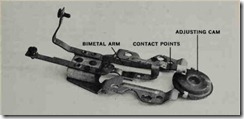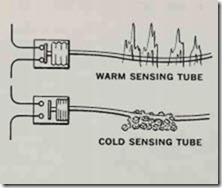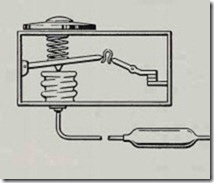The Thermostat
This is a switch which is either opened or closed by temperature change. The most common thermostat found in home appliances is the type known as a bimetal thermostat, so-called because of the way in which the mechanical action to open and close switch contacts is derived. In a bimetal thermostat, two dissimilar metals are bonded together. As they are heated or cooled, the differences in their rate of expansion cause a bending or warping action of the piece of metal. This mechanical action is used to operate switch contacts.
Bimetal thermostats are found in a large variety of shapes and sizes and temperature ranges. A few common applications are found in controlling heat in electric irons, automatic toasters, electric water heaters, clothes dryers, and motor protecting devices. In testing a thermostat, it is imperative to know the temperature at which the switch should actuate and also know whether you should read that the switch is closed or open when you put your VOM on it. Specifications are found in service manuals, but in the case of fixed temperature thermostats, the temperature point will usually be stamped on the body of the thermostat. For instance, L 150 found on the body of a bimetal thermo stat would indicate that this thermostat opens at 150 degrees.
Another class of thermostat is usually adjustable, the kind found on stoves and refrigerators. These are capillary tube or hydraulic ‘stats.
Cutaway view of water heater thermo stat reveals bimetal construction. These switches are not serviceable if any section of the thermostat fails, it must be replaced.
This hydraulic thermostat shows the sensing bulb, capillary tube, and bel lows assembly. The linkage from the bellows is attached to the contacts to provide switching action.
How A Bimetal Thermostat Works
Bimetal thermostatic control in photo, removed from an electric iron, il lustrates the principle shown in the series of three drawings.
- In the drawing at left, current flows through closed contacts of the bimetal switch and through heating element, which supplies heat to both appliance and to the switch itself.
- In center drawing, heat has caused bimetal arm to warp up wards, breaking electrical circuit. Appliance now cools until bimetal arm again makes contact. Cycle repeats and temperature of the iron stabilizes at a point that is dependent on the time of cycling.
- Drawing at right shows how heat range can be adjusted by varying position of second contact. By raising it on the threaded shaft, more heat is needed to lift bimetal contact. Shorter cool-down period is effected, resulting in higher overall temperature of the iron.
How A Basic Capillary Tube Thermostat Works
Switch contacts are connected by linkage to a flexible metal bellows which has a small tube called a capillary tube connected to it. The length of the tube is determined by the application for which it is to be used. This tube is usually filled with a substance such as freon gas of the type used in refrigerators. The tube is crimped and sealed at one end, the other end opening into the sealed bellows. When a portion of the tube is exposed to heat, the refrigerant inside will expand, causing the bellows at the other end to move and to open or close the switch depending upon the design and application of the thermostat. As the tube is cooled, the refrigerant contracts, causing the bellows to contract, and again this reverse movement initiates switch action.
Here’s how a basic capillary tube thermostat works. The tube and charge of gas, which is designed to work at a particular temperature range depending upon application, is attached to a set of switch contacts. This one is designed for use in a refrigerator. When the temperature be comes warmer, the bellows expands and closes the contacts, starting the compressor. When the temperature becomes colder, the bellows contracts a.nd opens the contacts.
A thermostat as simple as the one above has two shortcomings: It doesn’t allow for any means of control, and the contacts don’t snap open quickly enough to eliminate arcing.
The thermostat above has a counterforce to the bellows action, in the form of a spring, which is adjusted by the setting of the dial knob. The toggle spring now imparts a snap action to the contacts. This is basically how the majority of these thermostats operate on modern refrigerators. Courtesy Whirlpool Corp.
Adjusting The Rate Of Expansion And Contraction
The rate of expansion and contraction may be adjustable by a spring load upon the bellows or switch linkage. For instance, when you set your oven thermostat to 300 degrees, what you’re actually doing is setting up a precalculated spring load against the bellows of your oven’s thermostat. As the oven heats, the pressure within the bellows builds up to a point where it finally overcomes the spring load, which should occur at approximately 300 degrees. This movement opens the contacts, and the heating element within the oven is turned off. Again, as the oven cools below 300 degrees, the bellows contracts and the switch is closed, completing the circuit to the heating element. It continues to cycle in this manner until the thermostat is turned off or set to a different temperature. Thermostats such as these are durable and extremely accurate.





